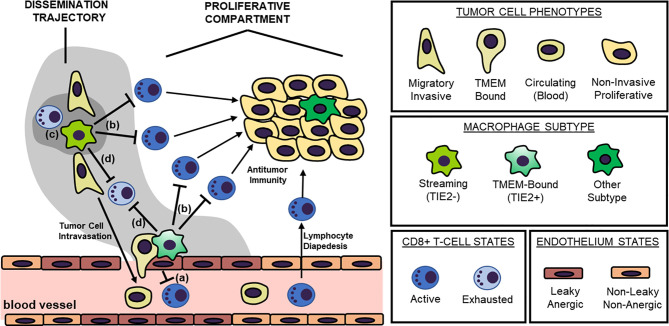Figure 1.
The “Dissemination Trajectory” Working Model of Metastatic Dissemination. Two major cellular prerequisites are necessary for cancer cell dissemination: a TMEM doorway and a highly invasive, highly migratory cancer cell subsets streaming toward TMEM doorways. TMEM doorways are composed of three cell types, a TIE2+ macrophage, an endothelial cell and a tumor cell forming an invadopod in the vasculature, and signaling conversation among these three cells results in localized vascular opening to facilitate transendothelial migration of the highly invasive, highly migratory cancer cell subset. The highly invasive and migratory cancer cell subsets participate in a reciprocal paracrine and juxtacrine signaling loop with intratumoral macrophages that do not express TIE2, resulting in the increased induction of the actin-regulatory protein MENAINV. Eventually, these interactions result in the so called “streaming migration”, which is directed toward TMEM doorways, and MENAINV-facilitated transendothelial migration and metastatic dissemination. TMEM doorways and their streaming MENAINV+ cancer cell subsets are herewith referred to as “dissemination trajectories”. These specialized microenvironments are distinguishable from other tumor compartments with rapidly dividing tumor cells that do not share similar molecular pathways, here described as “proliferative compartments”. Four layers of immunosuppressive mechanisms dominate within the dissemination trajectories, that result in the development of immune deserts further facilitating the process of metastatic dissemination. These mechanisms postulate that: (a) the TMEM endothelium is anergic, thus not allowing for T cell diapedesis; (b) dissemination trajectories do not support cytokine/chemokine matching for allowing T cell chemotaxis; (c) dissemination trajectories have a unique metabolic landscape that is refractory for T cell chemotaxis and/or function; and finally (d) dissemination trajectories are characterized by the induction of immune checkpoint signaling, that promoted exhaustion of T cells. Overall, tumor-associated macrophages (TAMs) within these dissemination trajectories play the pivotal role in regulating all four layers of immunosuppression, although secondary mechanisms have also been identified.

